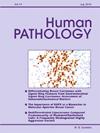雌激素受体在人类肿瘤中的表达:一项组织微阵列研究评估了来自149个不同实体的18,000多个肿瘤
IF 2.7
2区 医学
Q2 PATHOLOGY
引用次数: 0
摘要
雌激素受体(Estrogen receptor, ER)是一种配体激活的转录因子,在多器官系统的发育和功能中起着至关重要的作用,是公认的乳腺癌药物靶点。为了综合评价ER在正常组织和肿瘤组织中的表达,我们采用免疫组化(IHC)方法分析了包含149种不同肿瘤类型和亚型的18,560个样本和76种不同正常组织类型的608个样本的组织芯片。在55种不同的肿瘤类型中发现ER阳性,其中26个实体至少有一个强阳性肿瘤。ER阳性在乳腺肿瘤(81.1%)和其他妇科肿瘤(39.4%)中占优势,而在非妇科和非乳腺肿瘤中,ER阳性仅占0.8%。其中,ER染色-通常强度较低-尤其见于神经内分泌肿瘤(高达9.1%),唾液腺肿瘤(高达8.3%)和不同起源部位的鳞状细胞癌(高达6.7%)。在浸润性乳腺癌(NST)中,ER免疫染色降低与高pT (p <;0.0001),高等级(p <;0.0001),远处转移(p = 0.0012), HER2阳性(p <;0.0001), PR负性(p <;0.0001)和更短的总生存期(p = 0.0576)。浆液性高级别卵巢癌中,ER染色降低与淋巴结转移有关(p = 0.0012)。在145例可分析的子宫内膜样癌中,ER染色与组织病理学特征无关。在非乳腺、非妇科、非前列腺和非睾丸肿瘤中,ER阳性在女性肿瘤(2528例中为1.4%)中比男性肿瘤(3228例中为0.6%;p = 0.0003)。总之,我们的数据提供了一个肿瘤实体的排序列表,根据其ER阳性的患病率,并表明ER可以在少数非乳腺和非妇科肿瘤中强烈表达,这可能代表了未知原发癌症的诊断缺陷,但也代表了治疗机会。本文章由计算机程序翻译,如有差异,请以英文原文为准。
Estrogen receptor expression in human tumors: A tissue microarray study evaluating more than 18,000 tumors from 149 different entities
Estrogen receptor (ER) is a ligand-activated transcription factor with a critical role in development and function of multiple organ systems and a well-established drug target for breast cancer. To comprehensively evaluate ER expression in normal and tumor tissues, a tissue microarray containing 18,560 samples from 149 different tumor types and subtypes and 608 samples of 76 different normal tissue types was analyzed by immunohistochemistry (IHC). ER positivity was found in 55 different tumor types including 26 entities with at least one strongly positive tumor. ER positivity strongly predominated in breast neoplasms (81.1%) and in other gynecological tumors (39.4%) while only 0.8% of non-gynecological and non-mammary tumors showed ER positivity. Among these, ER staining – often at lower intensity – especially occurred in neuroendocrine neoplasms (up to 9.1%), salivary gland tumors (up to 8.3%), and in squamous cell carcinomas of different sites of origin (up to 6.7%). In invasive breast carcinoma (NST), reduced ER immunostaining was linked to high pT (p < 0.0001), high grade (p < 0.0001), distant metastasis (p = 0.0012), HER2 positivity (p < 0.0001), PR negativity (p < 0.0001) and shorter overall survival (p = 0.0576). In serous high-grade ovarian cancer, reduced ER staining was linked to nodal metastasis (p = 0.0012). ER staining was unrelated to histopathological features in 145 analyzable endometroid endometrial carcinomas. Within non-mammary, non-gynecological, non-prostate, and non-testicular tumors, ER positivity was more common in tumors from female (1.4% of 2528) than from male patients (0.6% of 3228; p = 0.0003). In summary, our data provide a ranking list of tumor entities according to their prevalence of ER positivity and shows that ER can be strongly expressed in a small number of non-breast and non-gynecological tumors which could potentially represent a diagnostic pitfall in a cancer of unknown primary but also represents a therapeutic opportunity.
求助全文
通过发布文献求助,成功后即可免费获取论文全文。
去求助
来源期刊

Human pathology
医学-病理学
CiteScore
5.30
自引率
6.10%
发文量
206
审稿时长
21 days
期刊介绍:
Human Pathology is designed to bring information of clinicopathologic significance to human disease to the laboratory and clinical physician. It presents information drawn from morphologic and clinical laboratory studies with direct relevance to the understanding of human diseases. Papers published concern morphologic and clinicopathologic observations, reviews of diseases, analyses of problems in pathology, significant collections of case material and advances in concepts or techniques of value in the analysis and diagnosis of disease. Theoretical and experimental pathology and molecular biology pertinent to human disease are included. This critical journal is well illustrated with exceptional reproductions of photomicrographs and microscopic anatomy.
 求助内容:
求助内容: 应助结果提醒方式:
应助结果提醒方式:


